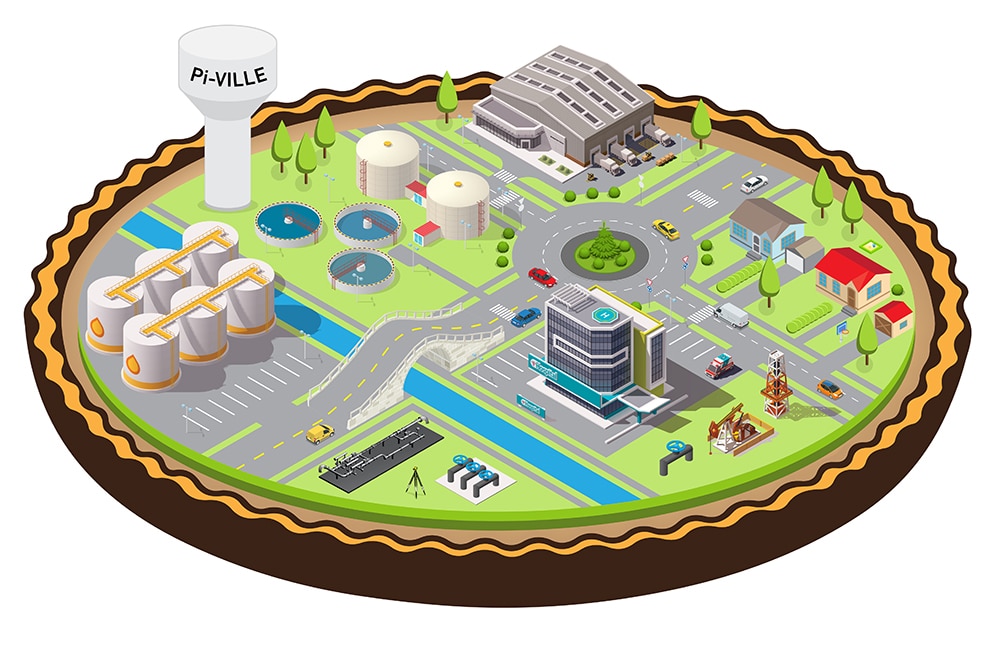 As the most recognized mathematical constant in the world, Pi is a bit of a celebrity. Like any starlet, it is fascinating, elusive, and mystifying. Simply put, when you divide a circle’s circumference by its diameter, you get pi — a transcendental, irrational number that is an infinite decimal. The never-ending stream of digits (3.1415926…) has been studied by mathematicians for more than 4,000 years.
As the most recognized mathematical constant in the world, Pi is a bit of a celebrity. Like any starlet, it is fascinating, elusive, and mystifying. Simply put, when you divide a circle’s circumference by its diameter, you get pi — a transcendental, irrational number that is an infinite decimal. The never-ending stream of digits (3.1415926…) has been studied by mathematicians for more than 4,000 years.
McClure Engineering Company’s engineers use pi every day in their designs. For example, an engineer will use pi to calculate vehicle turning radius to determine the layout of curb returns and drives. At water treatment plants, the required volume and capacity of a pipe is calculated using pi. Engineers also use pi when designing roadways, which helps them determine how much paving material is required for roundabouts and how large the stormwater pipes will need to be for drainage.
MEC shares its love of pi by delivering pies to key clients on National Pi Day. These round treats are a tasty reminder of how pi enables us to design and build better communities. In 2018, MEC employees packed 188 bags with 297 pies, 1668 each of napkins, plates, and utensils, and 150 pie servers to prepare for Pi Day. The nearly 300 apple, cherry, peach, and razzleberry pies were dropped off throughout the Kansas City metro, as well as Oklahoma City and Tulsa, Okla., and Columbia and Macon, Mo.
Pi and pie are more than just homonyms. Humans have been eating pie as long as pi has been used in mathematics! Here are some fun facts about pie.
- Although the origins of pie can be traced back to the Egyptians in 6000 BC, the ancient Greeks perfected the pie pastry. They added fat to a flour-water paste to make small pies and fill them with meat or fruit before they were cooked.
- After conquering Greece, the Romans adopted pie-making into their culture. A first-century Roman cookbook makes mention of pie cases in a variety of recipes.
- By 160 BC, the expansion of the Roman Empire proliferated pie-making throughout Europe.
- The first reference to the word “pyes” was in 12th century England.
- Early American settlers brought their pie recipes to the New World and filled them with berries and fruits. Colonial women used round pans to “cut the corners,” forever associating pie with pi.
- Original apple pie recipes came from England. The only native apple to the United States is the crabapple.
- In 2017, the American Pie Council’s National Pie Championship “Best in Show” recipes were Checkboard Peanut Butter Pie (amateur) and Dreamy Lemon Pie (professional).
- Today, meat pies, pot pies, and fruit pies are still eaten throughout the world.
Hungry for more? Settle in with your favorite circular dessert and learn about pi.
Crunching the Numbers, Pi-Style
- 22/7 is the closest rational simple fraction to pi.
- 314159, the first six digits of pi appear in order at least six times among the first 10 million decimals of pi.
- The number 1 is the most commonly occurring number in the first 100,000 decimal places of pi. It occurs 10,137 times.
- The number 360 is the 359th digit position of pi.
- There are no zeros in the first 31 digits of pi.
- Feynman point is the name for the six nines in a row that start at decimal point number 762.
- It would take 12 billion digits of pi typed in a normal font to reach from Kansas to New York City.
Computing Pi
- 1949: The Electronic Numeric Integrator and Computer (ENIC) took 70 hours to compute the first 2,037 decimal places of pi.
- 2009: Fabrice Bellard discovered the most digits of pi – nearly 2.7 million in 90 days with a $3,000 desktop PC (previous record holders used multi-million dollar supercomputers).
- 2010: Shigeru Kondo computed 5 trillion digits using a server-class machine using dual Intel xeon processors equipped with 96 GB of RAM.
A Slice of Pi History
- 2000 BC: Babylonians established the contact circle ratio as 3-1/8 or 3.125.
- 1650 BC: Egyptian scribe Ahmes wrote the earliest known record of pi, which is known as the Rhind Papyrus. He was less than 1 percent off the modern approximation of pi (3.141592…).
- 700: Pi was applied to other curves and eventually ripples emanating from a central point.
- 800: Al-Khwarizmi worked on a value of pi calculated to four digits: 3.1416.
- 1519: Leonardo da Vinci briefly worked on approximating pi.
- 1610: Ludolph van Ceulen spent most of his life calculating the first 36 digits of pi. The Ludolphine Number was rumored to have been engraved on his tombstone.
- 1666: Isaac Newton calculated pi to at least 16 decimal places.
- 1706: William Jones introduced the symbol π for pi. It was later popularized by Leonhard Euler in 1737.
- 1879: Albert Einstein is born on March 14.
- 1897: The state legislature of Indiana proposed a bill to ascertain the most exact value of pi (the bill never passed).
- 1988: The first Pi Day celebration was organized by Physicist Larry Shaw, aka The Prince of Pi.
- 2015: Rajveer Meena of India obtained the world record for most decimal places of pi memorized. He recalled 70,000 numbers, which took nearly 10 hours.

















